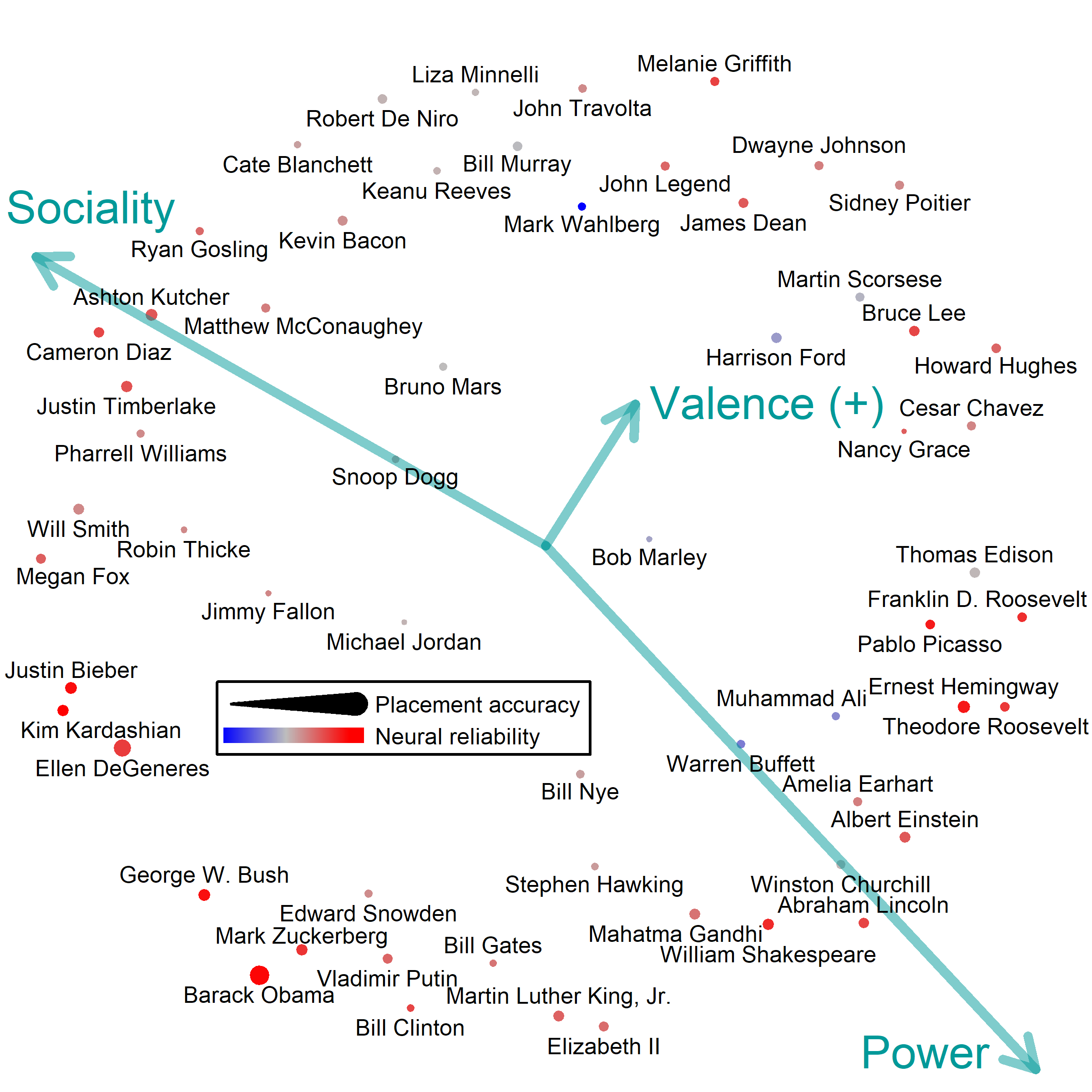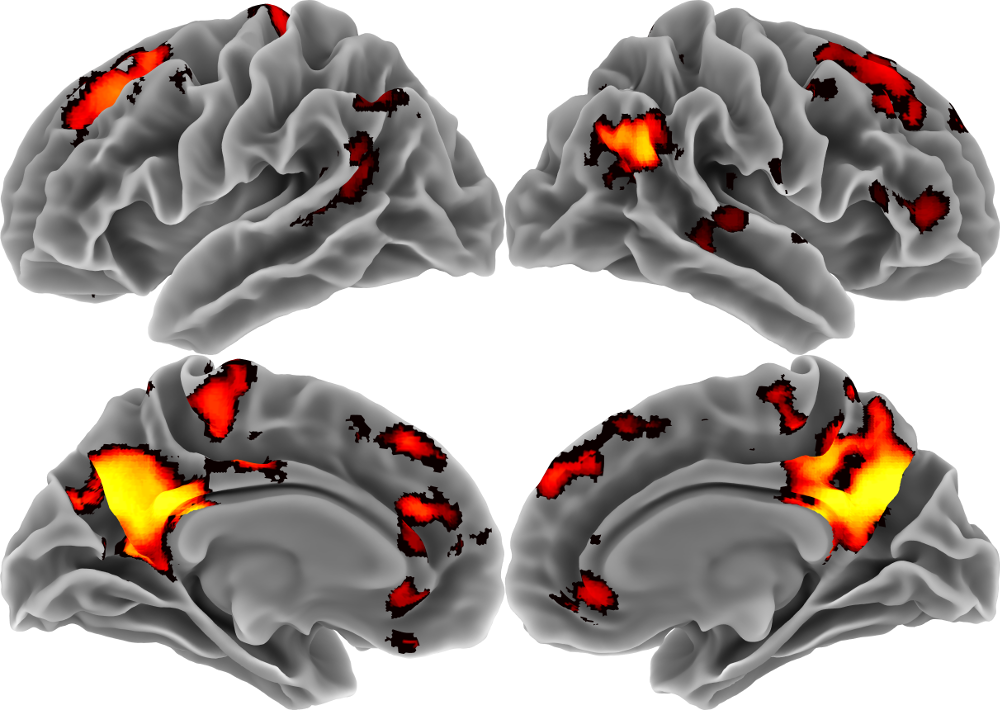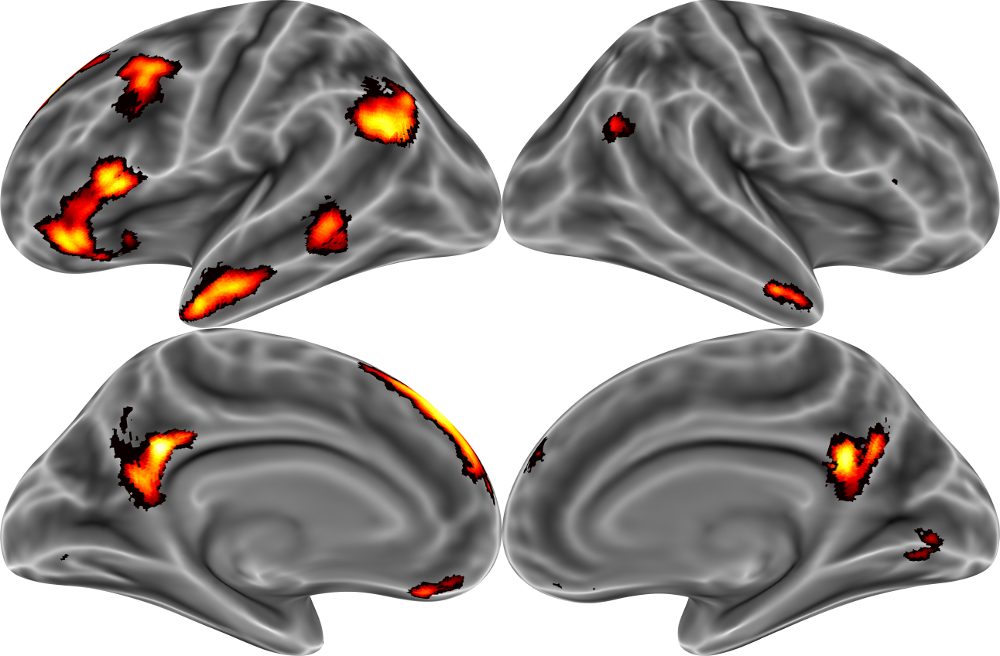Postings on science, wine, and the mind, among other things.
Using the brain to map our understanding of 'person-space'
Pop summary of Thornton & Mitchell 2017a&b

A 2-D 'map' of the similarity between brain activity patterns elicited when thinking about different famous people. Closer people elicit more similar neural patterns in participants. Like maps of Earth, this projection is imperfect - more than two dimensions are necessary to capture reality. The accuracy of the placement of points increases with point size. Color indicates the reliability of activity patterns, with red points indicating people who elicit consistent patterns across participants. The dimensions of the projection are not intrinsically meaningful, so biplots (arrows) indicate how the space relates to interpretable axes.
How do we understand other people? This question has been the subject of much discourse over human history, but within the last century, the fields of social and personality psychology have started to provide scientific answers. Although the particulars of these answers differ from one theory to the next, one theme that many answers share is the notion that we make sense of others by organizing them within a 'map' of social space. Just as maps of physical space help us navigate from one place to another, maps of social space may help us navigate the seas of social complexity by reducing the complexity of another person to a few essential coordinates.
If our minds do create maps of the social world, what are their dimensions? Does person-space have a north, south, east, and west, or longitude and latitude lines? In other words, what are the key dimensions along which we evaluate and compare other people? In two recently published works with my Ph.D. advisor, Jason Mitchell, I investigated this question using a nascent approach: pattern analysis of functional brain imaging.
In the first study, our primary goal was to identify which brain regions have consistently different patterns of brain activity when one thinks about different people. To assess this, we asked participants in the fMRI scanner to imagine 20 people they knew personally (friends, family, co-workers, etc.) in six different contexts: at the beach, shopping for groceries, at a local fair, waiting for a doctor, having dinner at a restaurant, and taking a long road trip. We chose these scenarios to be relatively open-ended and different from one another, but to still be common things which most people could be imagined doing.
We analyzed this data by comparing local patterns of brain activity across all of the trials of the experiment. We were specifically looking for regions which had patterns that were similar across all presentations of the same person. The reasoning was that brain regions that represent the core of our person knowledge should activate consistently whenever one thinks about a particular person, regardless of what scenario we imagine them in. We found such results in the regions shown in red/yellow on the stylized brain below. These regions included portions of medial prefrontal cortex (right behind the middle of your forehead), lateral prefrontal cortex (above your temples), and medial parietal cortex and the temporoparietal junction (the back of the top of your head, middle and sides respectively). All of these regions have been frequently been implicated in social cognition before, so they were reasonable locations to expect person knowledge to reside. We conducted the same analysis with respect to the six contexts as well, and found that the only overlap between these two types of information was in the medial parietal cortex.

Having identified a set of regions which appeared to represent information about other people, we followed up by probing the nature of these representations. We investigated whether several different dimensional accounts of person knowledge might account for the similarity between patterns expressed when thinking about different people using a technique known as representational similarity analysis. In this approach, we calculate the similarity between patterns elicited by each of the target people, and then test whether we can predict which patterns are more similar based on which people have closer positions on the dimensions of a theory. For instance, in a theory consisting of two dimensions - such as warmth and competence, in the stereotype content model - two target people who are both in the cold and competent quadrant of the space should elicit more similar patterns of activity than two people in different quadrants.
The results of this analysis were mixed. There was evidence that two factors were associated with neural pattern similarity: behavioral judgements of similarity between the targets, and how vividly and accurately participants believed they had imagined the target people. For other dimensional maps of person-space, including several established theories from the social psychological literature, there was only tentative support at best.
Given the ambiguous nature of these results, we felt another study was called-for. This new study would not merely look for the presence of certain dimensions influence. It would also have the power to discriminate between different theories of person perception, to determine not only which worked, but which was best. To achieve this, we altered our stimuli and task: participants in the second study would be asked to make specific inferences about a set of famous people. Thus, on a particular trial, a participant might be asked to judge how much Bill Nye would like to learn karate. We chose items that were as statistically differentiable as possible, and to which participants would be unlikely to know the answers for a fact (forcing them to rely on their general knowledge of the person in question to make an inference). The famous people were selected to be widely known but as diverse as possible within that constraint, using a combination of human ratings and text analysis of Wikipedia biographies.
One valuable aspect of choosing famous people for this study was that it allowed our participants to all think about the same set of target people. This enabled us to calculate the reliability of responses to particular target people across participants. In the regions shown in red/yellow below, we observed highly reliable responses across participants in terms of both individual voxels (3-D pixels) and the overall pattern across voxels. Although the regions differ slightly from those we previously implicated in representing personally familiar people, the overall patterns tells a very similar story, again primarily involving medial and lateral prefrontal and parietal cortices.

Within these regions, we could measure the similarity between patterns elicited by thinking about different target people. This similarity is visualized in the map at the top of this post. Using these patterns of brain activity, we again tested whether dimensional (map-like) theories of person perception could predict patterns of brain activity. To do so we used a technique known as an encoding model. Encoding models are somewhat complex, but cooking provides us with an accessible analogy. Think about all of the ingredients in your fridge or pantry at home. These ingredients could be combined in different ratios to produce a wide variety of different dishes. Some ingredients are more common, or more versatile than others: many dishes require the use of olive oil, but relatively few call for the use of octopus.
Now imagine yourself in an Iron Chef-like competition in which you are provided with only a small number of ingredients, and instructed to recreate a certain dish as best you can. Your success will naturally depend in large part on which ingredients you were assigned: it is difficult to recreate a Caesar salad with only sirloin steak and blackberries. This is roughly how an encoding model works: one provides it with a small number of ingredients (in this case, dimensions of a theory of person perception), and the model's success can be measured in terms of how well those ingredients recreate a dish (the neural activity associated with a particular celebrity). At this point the analogy breaks down a bit, as the most versatile or common foods are not necessarily the best tasting. However, in the context of our encoding model, a good theory will be one which can accurately reconstruct activity patterns.
Using this approach, we find that all four of the existing theories of person perception we tested were able to reconstruct activity well above chance levels. The performances of these theories were generally quite similar, but all four were (unsurprisingly) beaten by a synthetic 3-dimensional model that combined their features. Indeed, this synthetic theory achieved 2/3rds of the estimated performance of a hypothetical ideal theory. Although this estimate is likely to be something of an overestimate, it suggests that social psychology is well more than half way towards a complete description of our mental map of the social world. The dimensions of this synthetic model, which we called power, valence, and sociality, are plotted on the map above.
Why were these results so much more bullish than those of the first study? It is possible that people apply dimensional representations more to famous others than to personally familiar others. However, much of the difference is likely methodological: we had more data, both within and across participants, in the second study, and we measured the positions of people within the dimensional space with greater reliability by calling on large samples of online raters. These improvements in measurement likely account for much of our ability to detect the influence of trait dimensions better in the second study.
The theories of person perception we tested proved capable of impressive generalization. Not only could they predict the activity patterns associated with previously "un-seen" (by the model) target people, the encoding models could also predict activity in the brains of different participants. In other words, even without collecting any data from you personally, I could still use these models to make a better-than-chance guess at what your brain activity would look like if you thought about Justin Bieber. Even more excitingly, two of the theories - the stereotype content model and our synthetic 3-D model - generalized across the trait-state boundary. We could use encoding models trained on the famous people to predict patterns of brain activity associated with thinking about particular mental states (happy, angry, planning, etc.) in a separate study. This suggests that whenever you think about a habitually positive person, the pattern of activity in your brain literally resembles the pattern that would be elicited if you thought about a positive state, such as relaxation.
In conclusion, across two studies we observed that a consistent set of brain regions appear to represent detailed knowledge about other people. Moreover, in the second study we found positive evidence that the dimensions of several established theories of person perception can describe much of the brain activity associated with thinking about well-known public figures. This result supports the notion that we implicitly organize our knowledge about the social world using mental maps of person-space. I am currently following-up on these findings in an effort to discover whether and how such maps might serve as a scaffolding for making predictions about other people.
Links to the scientific articles we published about these two studies can be found here. You can also find links there to the Open Science Framework repositories where we have made our data and code publicly available for scrutiny and re-use by others.
© 2017 Mark Allen Thornton. All rights reserved.
